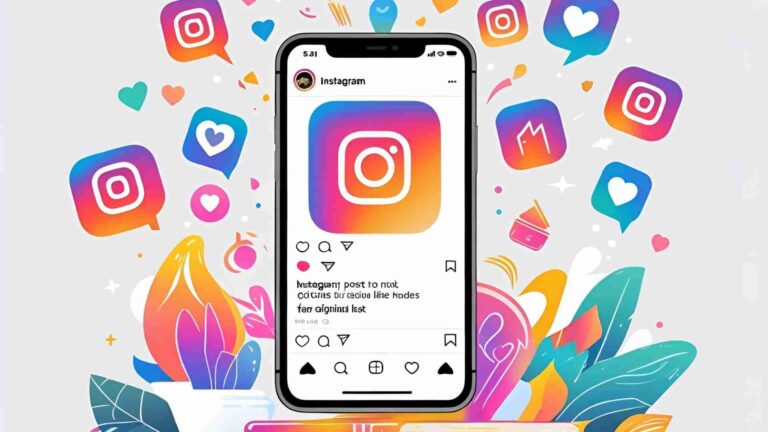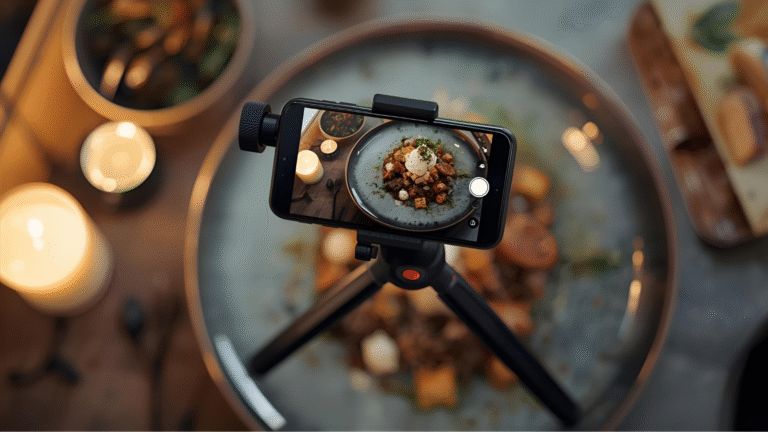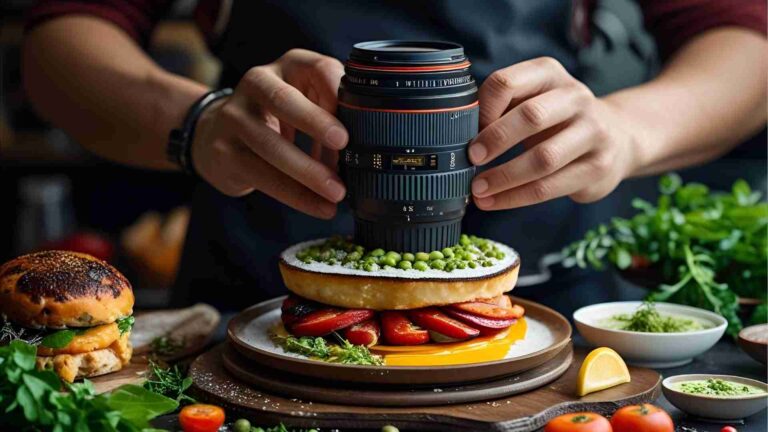A Huge SEO Tip That Most Food Bloggers Miss
Boost your food blog’s SEO with this powerful tip: leverage image sharing for link building. Learn actionable strategies to enhance rankings.
Search engine optimization (SEO) is a critical component for growing a successful food blog. While many bloggers grasp the basics of SEO—such as optimizing titles, URLs, and content—standing out in the crowded food blogging niche requires specialized strategies that others may overlook. This article explores a high-impact, niche-specific SEO tip that can give food bloggers a competitive edge in search engine rankings. By focusing on a unique approach to link building, leveraging tools like Google’s Reverse Image Search, and adopting a proactive mindset, food bloggers can transform challenges into opportunities to boost their site’s authority and traffic.
The Power of Perspective: Turning Problems into Opportunities
To understand the SEO tip, let’s first explore a broader business concept through a historical lens: the rise and fall of Napster. In the early 2000s, Napster, a peer-to-peer file-sharing platform, revolutionized how people accessed music. It allowed users to share MP3 files, like Train’s Drops of Jupiter or Savage Garden’s I Knew I Loved You, rapidly growing to 25 million users in under two years. However, record labels saw this as a threat, focusing on the illegality of file sharing rather than the opportunity it presented. They implemented restrictive measures, such as secure CDs, which alienated fans and artists alike.
Instead of fighting file sharing, forward-thinking labels could have embraced the trend, finding ways to make music more accessible while maintaining profitability. This missed opportunity highlights a key lesson: sometimes, what appears to be a problem is actually a chance for innovation.
For food bloggers, a similar mindset shift can turn a common frustration—unauthorized use of photos or recipes—into an SEO advantage. When someone uses your content without permission, it’s natural to feel angry or protective. However, by reframing this as an opportunity for link building, you can harness sharing to boost your blog’s visibility.
The SEO Tip: Leverage Image Sharing for Link Building
The core of this SEO strategy lies in transforming unauthorized content use into a chance to build high-quality backlinks, which are among the most influential off-page SEO factors. Backlinks—links from other websites pointing to your blog—signal to search engines like Google that your content is trustworthy and authoritative. According to Moz, a leading SEO authority, links are a significant part of search engine algorithms, contributing to metrics like trust, authority, and popularity.
When another website uses your food photos or recipes without linking back to your blog, it’s akin to a bee taking pollen from a flower. While the act may seem like theft, it can facilitate cross-pollination—spreading your content’s reach and strengthening your blog if you secure a backlink. Here’s how to implement this strategy effectively:
Step 1: Identify Unauthorized Use with Google’s Reverse Image Search
Google’s Reverse Image Search is a powerful tool for food bloggers to find websites using their images. This tool scans the web for instances of your photos, providing a list of sites in seconds. To use it:
- Access the Tool: Visit Google Images and click the camera icon in the search bar to upload an image or paste its URL.
- Browser Extensions: For efficiency, install the Search by Image extension for Chrome or Firefox, which allows you to right-click an image on your blog and search for it instantly.
This process reveals websites that have republished your images, whether they’re blogs, recipe aggregators, or social media platforms.
Step 2: Reach Out to Request Backlinks
Once you’ve identified sites using your images, the next step is to contact their owners and request proper attribution through backlinks. The key is to approach this diplomatically to maximize cooperation. Here’s a sample outreach email inspired by Pinch of Yum:
Subject: Request for Image Attribution
Dear [Website Owner],
I noticed you’ve shared an image from [Your Blog Name]’s [Post Title] post on your website at [URL]. We’re thrilled you love the photo! To comply with our content usage policy, we kindly request two links as credit:
1. A link to our homepage: [Your Blog URL]
2. A link to the original post: [Post URL]
Thank you for your cooperation, and feel free to reach out with any questions.
Best regards,
[Your Name]Tips for Effective Outreach:
- Assume Good Intent: Avoid accusatory language to foster goodwill.
- Provide Clear Instructions: Specify the exact links you want included.
- Find Contact Information: Use the site’s contact page, email (via WHOIS.net if not listed), or social media profiles.
Step 3: Monitor and Follow Up
Not all website owners will respond promptly or comply with your request. Your next steps depend on your priorities:
- Let It Go: If the site is low-quality or spammy, it may not be worth your time to pursue further. Such sites often fade naturally.
- Escalate if Necessary: For persistent violations, consider a DMCA takedown request. However, this can be time-consuming, and creating new content may be a better use of resources.
For recipes, which are harder to track, set up Google Alerts for unique phrases from your recipe instructions. This can help identify sites copying your text and allow you to request backlinks similarly.
Why Backlinks Matter for Food Blogs
To understand the impact of this strategy, let’s break down the role of backlinks in SEO. Search engines use two main types of SEO factors:
- On-Page Factors: Elements you control, such as title tags, URL structure, and structured data (e.g., Recipe schema). These are critical but relatively easy to optimize.
- Off-Page Factors: Elements outside your control, like backlinks and social shares. These are harder to influence, making them more valuable to search engines as indicators of trust.
Backlinks fall into three categories, as outlined by Moz:
- Natural Editorial Links: Organic links from other sites, highly valued for their authenticity.
- Manual Outreach Links: Links gained through requests, like the strategy described here.
- Self-Created Links: Low-quality links from forums or guestbooks, which have minimal SEO impact.
The strategy of requesting backlinks from sites using your images combines natural and manual link building, creating a powerful mix that can elevate your blog’s authority.
The Impact of Backlinks
A single backlink from a reputable site can significantly boost your rankings. For example, a link from a high-authority food blog or recipe aggregator can signal to Google that your content is credible. Over time, accumulating these links builds your blog’s topical authority, making it more likely to rank for competitive keywords.
Here’s a simplified view of how backlinks contribute to SEO:
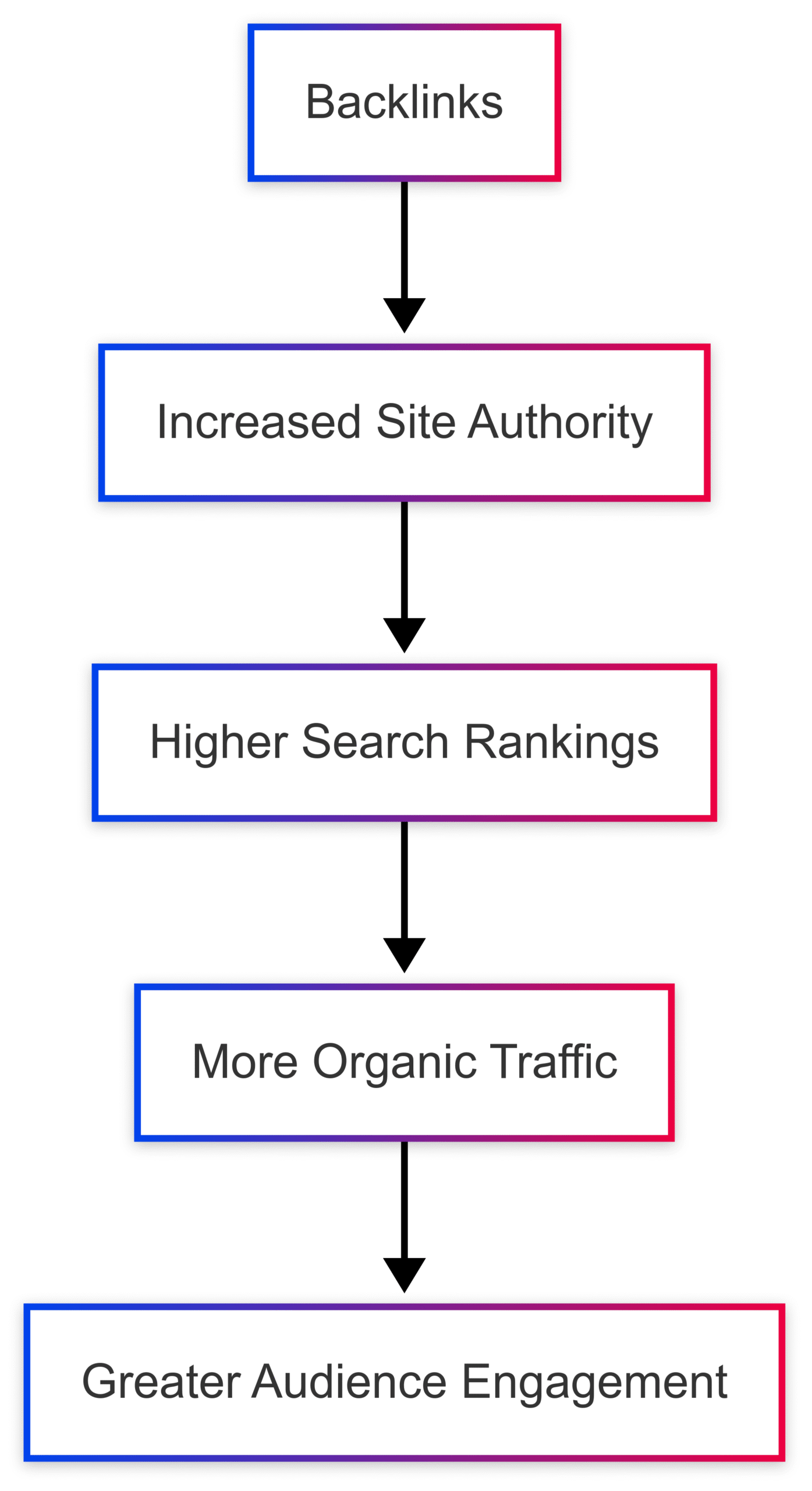
Complementary SEO Strategies for Food Bloggers
While the backlink strategy is powerful, it’s most effective when combined with other SEO best practices tailored to food blogs. Here are key strategies to amplify your efforts:
1. Focus on Long-Tail Keywords
Long-tail keywords—specific, multi-word phrases—have less competition and higher conversion potential. For example:
- Broad Keyword: “Pepperoni pizza” (67 million search results)
- Long-Tail Keyword: “Make pepperoni pizza less greasy” (2.9 million search results)
Tools like the Yoast Google Suggest Expander can help identify long-tail keywords, such as “paleo almond butter cookies,” which are easier to rank for due to lower competition.
Example Table: Keyword Comparison
| Keyword | Search Results (Approx.) | Competition Level |
|---|---|---|
| Pepperoni pizza | 67,000,000 | High |
| Make pepperoni pizza less greasy | 2,900,000 | Medium |
| Paleo almond butter cookies | 1,200,000 | Low |
2. Optimize with Recipe Schema
Implementing Schema.org’s Recipe structured data helps search engines understand your content, increasing the chances of appearing in rich snippets or Google Images. Key elements include:
- Cooking Time: Specify prep and cook times.
- Ingredients: List all ingredients clearly.
- Nutrition Information: Include calorie counts and macronutrients for health-conscious readers.
- Images: Use high-quality photos with descriptive alt tags.
The Yoast SEO plugin simplifies this process by automatically generating schema markup, though it doesn’t guarantee rich snippet placement.
3. Prioritize High-Quality Photography
Food blogs thrive on visuals. High-quality images not only attract readers but also improve SEO by increasing dwell time (the time users spend on your site). Invest in good photography equipment or learn smartphone photography techniques to create mouthwatering images. For example, a well-lit photo of a finished dish can drive clicks from Google Images or Pinterest.
4. Plan Seasonal Content
Seasonal posts, like Christmas recipes or summer BBQ guides, can drive significant traffic if planned early. Use Google Trends to identify peak search periods for seasonal keywords. For instance, searches for “Christmas recipes” spike in October and November, so publish and promote these posts well in advance.
Chart: Seasonal Content Planning
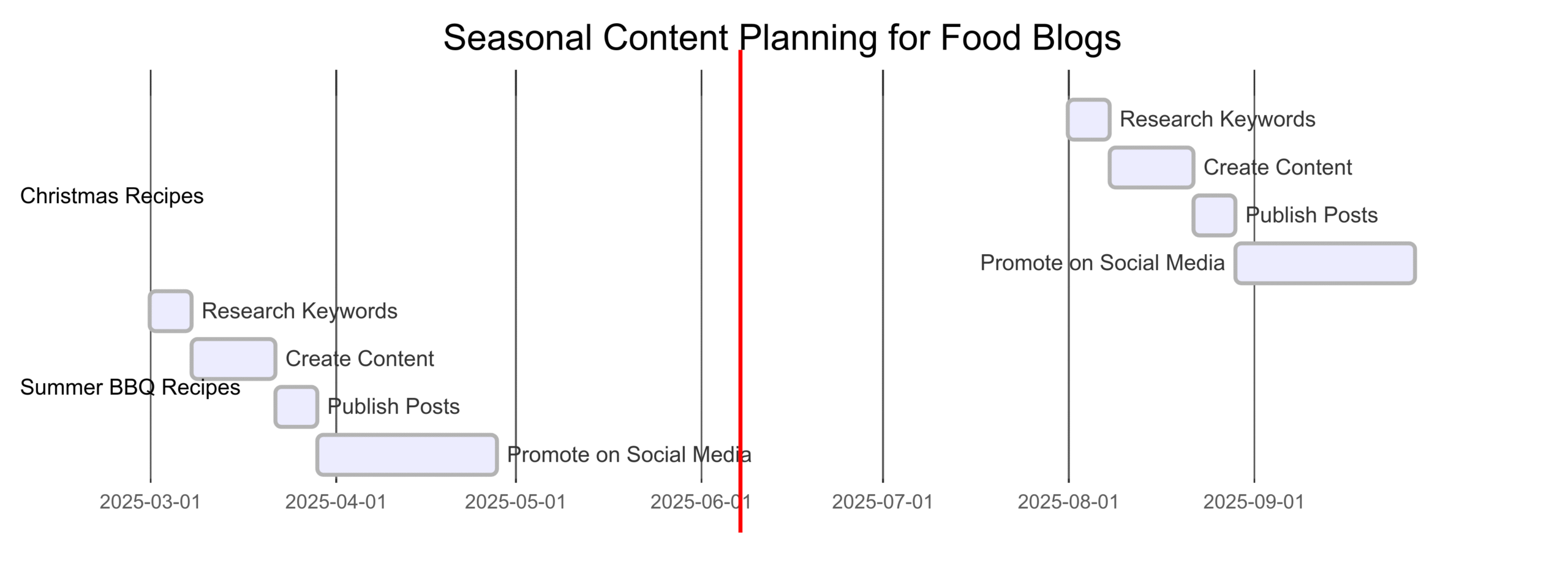
5. Leverage Social Media
Social media platforms like Pinterest and Instagram are ideal for food blogs due to their visual nature. Use hashtags like #foodporn or #instafood to increase discoverability. Additionally, consider creating YouTube content to tap into video search traffic, as demonstrated by channels like BarbecueWeb (2.18 million subscribers).
6. Write Reader-Centric Content
Great content is the foundation of SEO. Google prioritizes user experience, rewarding sites where visitors spend more time. Focus on:
- Quality Over Quantity: One exceptional post per week outperforms multiple mediocre posts.
- Engaging Visuals: Update old posts with new photos to boost traffic.
- Topical Authority: Create clusters of content around popular topics (e.g., leftover chicken recipes) to establish expertise.
7. Conduct Keyword and Competitor Research
Use tools like SEOBook’s Keyword Tool to identify high-traffic, low-competition keywords. For example, “blue cheese, walnut, and pear salad” may have less competition than “blue cheese salad.” Check Google search results to assess competitors—big players like BBC or Epicurious are tough to outrank, but smaller blogs indicate an opportunity.
8. Optimize Posts with Yoast SEO
The Yoast SEO plugin is a must-have for WordPress food bloggers. It:
- Analyzes keyword usage and readability.
- Generates sitemaps automatically.
- Allows customization of meta descriptions and URLs.
- Supports schema markup for recipes.
9. Build Internal Links
Internal links keep readers on your site longer, boosting SEO and page views. Link to related posts or category pages using keyword-rich anchor text (e.g., “best vegan dessert recipes” instead of “click here”).
10. Ensure Mobile Optimization
With over 50% of web traffic coming from mobile devices, a mobile-responsive site is non-negotiable. Use Google’s PageSpeed Insights to test and optimize your site’s mobile performance.
11. Use a Recipe Plugin
For recipe bloggers, plugins like WP Recipe Maker enhance SEO by formatting recipes for Google’s rich snippets. The paid version includes nutritional data and unit conversion, further improving user experience.
Table: Recipe Plugin Comparison
| Feature | WP Recipe Maker (Free) | WP Recipe Maker (Premium) |
|---|---|---|
| Recipe Schema | Yes | Yes |
| Nutritional Info | No | Yes |
| Unit Conversion | No | Yes |
| Price (One-Time) | Free | $49 (approx.) |
Measuring Success: Tracking SEO Progress
To gauge the effectiveness of this strategy, monitor your organic traffic using tools like Google Analytics or Search Console. Look for:
- Increased Backlinks: Use Ahrefs or Moz to track new links.
- Higher Rankings: Check keyword positions for targeted long-tail terms.
- Traffic Growth: Compare organic traffic before and after implementing the strategy.
For example, Pinch of Yum saw significant traffic growth after adopting this link-building approach, demonstrating its potential impact.
Conclusion: A Marathon, Not a Sprint
SEO for food blogs is a long-term endeavor that requires consistency and strategic thinking. By reframing unauthorized content use as an opportunity for link building, food bloggers can turn a challenge into a powerful SEO tool. Combine this with long-tail keyword focus, high-quality visuals, and technical optimizations like Yoast and recipe plugins to maximize your blog’s potential. Schedule weekly time to search for image usage and send outreach emails, and over time, you’ll build a robust backlink profile that elevates your blog’s authority and drives sustainable traffic.
Please share these A Huge SEO Tip That Most Food Bloggers Miss with your friends and do a comment below about your feedback.
We will meet you on next article.
Until you can read, Matcha Green Tea Energizing Smoothie Bowl


